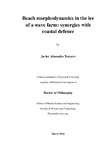Beach morphodynamics in the lee of a wave farm: synergies with coastal defence
| dc.contributor.supervisor | Iglesias Rodriguez, Gregorio | |
| dc.contributor.author | Abanades Tercero, Javier | |
| dc.contributor.other | School of Biological and Marine Sciences | en_US |
| dc.date.accessioned | 2017-04-05T09:14:37Z | |
| dc.date.available | 2017-04-05T09:14:37Z | |
| dc.date.issued | 2017 | |
| dc.identifier | 10426926 | en_US |
| dc.identifier.uri | http://hdl.handle.net/10026.1/8807 | |
| dc.description.abstract |
Wave energy has a great potential in many coastal areas thanks to a number of advantages: the abundant resource, the highest energy density of all renewables, the greater availability factors than e.g. wind or solar energy; and the low environmental and particularly visual impact. In addition, a novel advantage will be investigated in this work: the possibility of a synergetic use for carbon-free energy production and coastal protection. In this context, wave energy can contribute not only to decarbonising the energy supply and reducing greenhouse emissions, but also to mitigating coastal erosion. In effect, wave farms will be deployed nearshore to generate electricity from wave energy, and therefore the leeward coast will be exposed to a milder wave climate, which can potentially mitigate coastal erosion. This thesis aims to determine the effectiveness of wave farms for combating coastal erosion by means of a suite of state-of-the-art process-based numerical models that are applied in several case studies (Perranporth Beach,UK; and Xago Beach, Spain) and at different time scales (from the short-term to the long-term). A wave propagation model, SWAN, is used to establish the effects of the wave farm on the wave conditions. The outcomes of SWAN will be coupled to XBeach, a costal processes model that is applied to analyse the effects of the milder wave conditions on the coast. In addition to these models, empirical classifications and analytical solutions are used as well to characterise the alteration of the beach morphology due to the presence of a wave farm. The analysis of the wave farm impacts on the wave conditions and the beach morphology will be carried out through a set of ad hoc impact indicators. Parameters such as the reduction in the significant wave height, the performance of the wave farm, the effects on the seabed level and the erosion in the beach face area are defined to characterise these impacts. Moreover, the role played by the key design parameters of wave farms, e.g. farm-to-coast distance or layout, is also examined. The results from this analysis demonstrate that wave farms, in addition to their main purpose of generating carbon-free energy, are capable of reducing erosion at the coast. Storm-induced erosion is significantly reduced due to the presence of wave farms in the areas most at risk from this phenomenon. However, the effects of wave farms on the coast do not lend themselves to general statements, for they will depend on the wave farm design (WEC type, layout and farm-to-coast distance) and the characteristics of the area in question, as shown in this document for Perranporth and Xago. In summary, this synergy will improve the economic viability of wave farm projects through savings in conventional coastal defence measures, thereby fostering the development of this nascent renewable, reducing greenhouse gas emission and converging towards a more sustainable energy model. Thus, wave energy contributes to mitigating climate change by two means, one acting on the cause, the other on the effect: (i) by bringing down carbon emissions (cause) through its production of renewable energy, and (ii) by reducing coastal erosion (effect). | en_US |
| dc.language.iso | en | |
| dc.publisher | University of Plymouth | |
| dc.rights | CC0 1.0 Universal | * |
| dc.rights.uri | http://creativecommons.org/publicdomain/zero/1.0/ | * |
| dc.subject | Wave energy | en_US |
| dc.subject | Wave farm | en_US |
| dc.subject | Wave Energy Converter | en_US |
| dc.subject | Nearshore impact | en_US |
| dc.subject | Beach profile | en_US |
| dc.subject | Erosion | en_US |
| dc.subject | SWAN | en_US |
| dc.subject | XBeach | en_US |
| dc.subject | Sediment transport | en_US |
| dc.subject | Beach morphology | en_US |
| dc.subject | conceptual beach model | en_US |
| dc.subject.classification | PhD | en_US |
| dc.title | Beach morphodynamics in the lee of a wave farm: synergies with coastal defence | en_US |
| dc.type | Thesis | |
| plymouth.version | publishable | en_US |
| dc.identifier.doi | http://dx.doi.org/10.24382/960 | |
| dc.rights.embargoperiod | No embargo | en_US |
| dc.type.qualification | Doctorate | en_US |
| rioxxterms.version | NA |
Files in this item
This item appears in the following Collection(s)
-
01 Research Theses Main Collection
Research Theses Main



